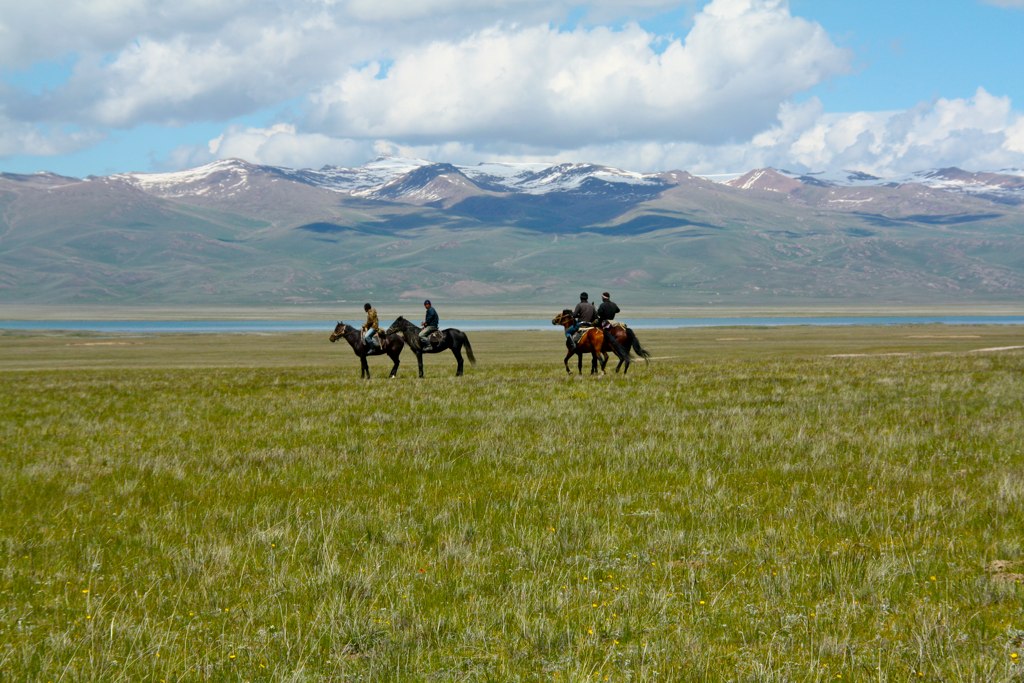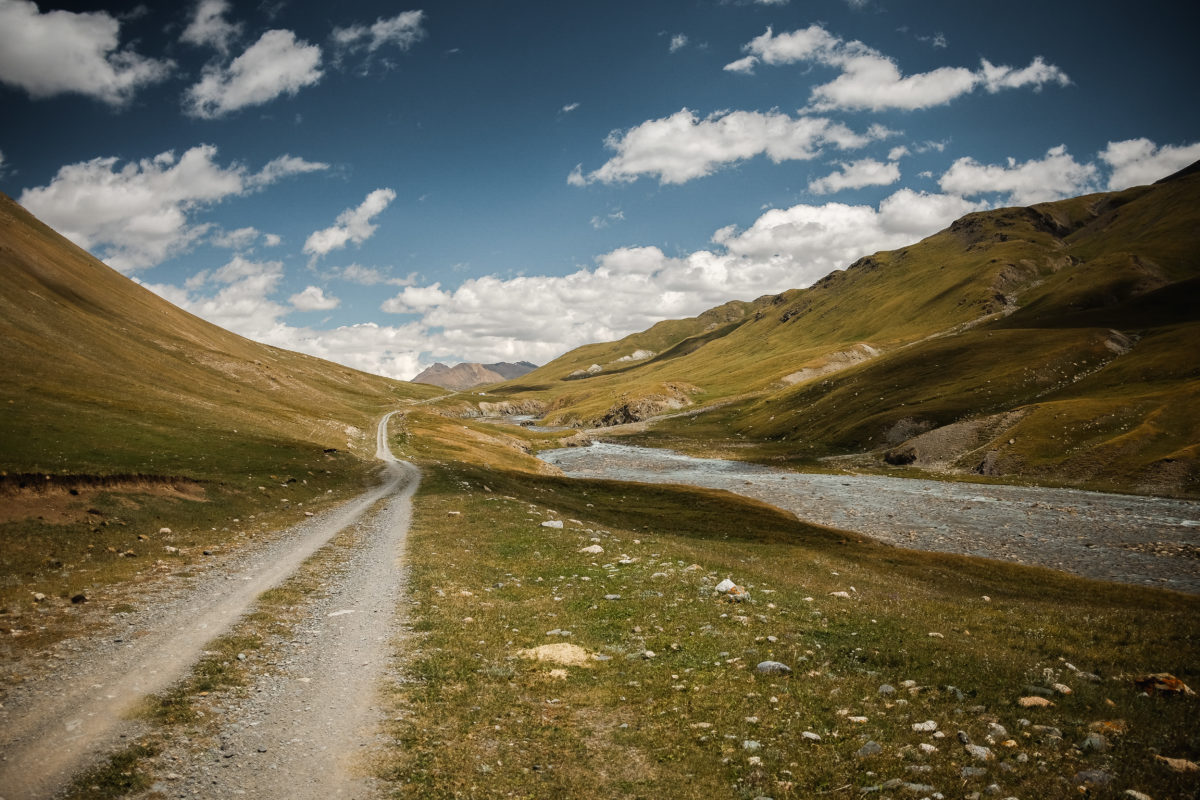
By : Julia Thimberg Silfwerling
“He says he will give you two horses if you marry his son,” Nargiza, our 22-year old translator says to me. She leans forward, munching on a slice of homemade bread with apricot jam while eagerly waiting for my response.
My friend Emma nearly chokes on her tea as she tries not to laugh out loud, both of us unsure whether it’s a joke or not. The son peers in at us from outside the yurta, the traditional, circular hut of the Kyrgyz, seemingly not the slightest bit amused by his father’s offer. He looks to be a few years younger than me with slightly sunburnt, tanned skin and crooked teeth.
“I got a boyfriend,” I answer. Hopefully, Nargiza won’t say anything about our talk from the previous night when I told her that I didn’t.
The language barrier between us and the shepherd whose yurta we are having lunch in makes it hard to spot humor. Knowing that bridal kidnappings still occur daily in Kyrgyzstan—over 11,000 girls a year are thought to be victims of this brutal, relatively new tradition despite it being illegal—we don’t know what other ways the Kyrgyz might arrange relationships. But despite this, it seemed to be a fairly liberal country. Nargiza had told us about her boyfriend in Bishkek, the capital, and during the horse treks she shares a tent with the guide— a 19-years old Beksultan perpetually in a three-striped Adidas tracksuit.
We had left Baskoon, a small town of dirt roads, overgrown apricot orchards and lamp posts with colourful election posters, six days earlier for our eight-day horse trek in the Terskey Alatau mountain range of east Kyrgyzstan. It’s the starting point for Shepherd’s Way Trekking, a company founded by two brothers in 1994 to provide guided horse treks through a landscape that looks like a mix between J. R. R. Tolkien’s Middle Earth and the American Wild West. Initially, it was mostly for international businessmen, but as Kyrgyzstan emerged as a tourist destination following the fall of Soviet in 1991, Shepherd’s Way Trekking grew as well, taking a new group of travellers into the mountains nearly every day throughout the summer.
Over two million tourists visit Kyrgyzstan, also known as “the Switzerland of Asia,” every year. The growing tourism industry isn’t popular among all though, and some worry what it will mean for the country. As Gulmirra, the wife of one of Shepherd’s Way Trekking’s founders, explained to us one morning over breakfast at her B&B in Baskoon, “The government needs to regulate the tourism. There are no ministers, the government is changing all the time. Sometimes [the tourism industry] belongs to sport, sometimes culture, there is no order. Everytime there’s a change we think ‘now our lives will get better’.”
She fears that the country will lose itself to tourism and end up like Nepal or Tibet, yet tourism brings in lifesaving money to a population that doesn’t have enough.
“Everybody is just trying to survive,” Gulmirra says.
Even in the middle of nowhere there are traces of trourists. Hours of driving from the nearest village, or days of riding, there is used toilet tissue spread out around the locations regularly used as camping sites. We are supposed to burn the paper, but the oxygen-poor air and the strong winds make it hard to light such a small fire. Some of the shepherds who live here build wobbly planks surrounding a hole in the ground—they can use, but despite the many yurtas we ride by, there aren’t many of these to be seen.
The shepherds move from the villages to live in the mountains between June and September each year, looking after the herds of cows, sheep, horses and yaks that roam freely along the grassy slopes and riversides during the summer. Some of them move here alone, like one shepherd who told us about his wife and five children still in his village, while others bring their entire family. One of the most common tasks the shepherds’ and their families do during the summer is to make kymyz, or “Kyrgyz champagne” as it’s called, which is the country’s favourite drink.
Kymyz is fermented horse milk sat in barrels before being poured into old PET bottles—“Kyrgyz Coca-Cola,” Nargiza jokingly called it—and picked up by a milkman who drives it to the cities and villages where it’s sold everywhere from market stalls to supermarkets. Once a milkman drove past us merrily waving and shouting a short conversation with Beksultan through the open window of his green, rusty hippie-bus replica.
We are generously offered kymyz in every yurta we are invited to. However, after our first and last cup of it, both Emma and I decided to stick with tea, never again wanting to experience the tart, spoiled and acidic taste of the watery, white liquid. This is to the great amusement of Nargiza and Beksultan who still offer us kymyz every time they are drinking it. Luckily, nobody seems to mind that we reject it every time. Instead we drink the weak black tea served in small, usually flowery, bowls, to which we can add as many spoons of sugar or homemade jam as we liked.

It is tradition in the mountains to invite travellers for tea, the yurta’s shade a needed break from the blazing sun and rough wind outside. The interior usually consists of a low table surrounded by matrasses, pillows or blankets with rugs on the dirt floor. Some of them have beds against the back walls, some a small radio, but all of them have a barrel of kymyz somewhere and smell of horse, old fabrics and smoke from the fire powered stove. And since the distance between neighbours can be big, inviting travellers is also a way for them to socialise and exchange news and gossip.
The breaks inside the yurtas are necessary since we spend all day outside at the mercy of the weather. We ride four to six hours a day, up rock slopes, through glistening rivers and across seas of grass. Even though I’m a seasoned rider, my body felt sore already after the second day, but that didn’t matter much. Not only because of the landscape’s vast, raw beauty, but because of the countless herds of animals we pass as they roam free, unlimited by fences or equipment, in a semi-wild state.
“It’s like you’ve never seen a horse before you’ve seen them like this,” Emma said one morning as we sat on a rock, watching a herd lead by a beautiful palomino mare make their way up the grassy mountain slope on the creek’s opposite side. This herd looked like a scene from my favourite movie as a child, “Spirit: the stallion of the Cimarron”, and we sat admiring them until Nargiza called that the breakfast was ready.
However, many horses didn’t have the fortune to roam free. As we pass the yurtas, rows of foals are tied up outside. This keeps their mothers close by while preventing the babies to suckle, so that the shepherds can milk the mares. In the villages, skinny horses graze amidst high, nutrient poor grass under the low, crocked branches in the fruit orchards. At one point we rode by a pinto horse laying dying by the side of the road, two men and one dog watching as the third shepherd was riding away to get a gun. Far away from the nearest veterinary clinic, the horses live a life as rough as their owners.
Kyrgyzstan’s GDP per capita being about 3% of the UK’s, and corruption is widespread. We could see this along the drive from Bishkek to Karakol, a city 280 miles east of the capital, along the beautiful, dry, southern shore of lake Issyk-Kul, the world’s second largest mountain lake which is said to have gotten its salty water from the tears of a princess who was prohibited to marry the commoner she loved. Abandoned construction projects— resorts, apartment complexes and villas—are eerie skeletons of ambition that stand like reminders of what happens when money never reaches its final destination. Concrete walls, metal beams and dark, glass-less windows gape at you when you drive along the bumpy roads, looking like sad caricatures of development.
In the cities, crumbling wooden houses sit next to tin sheds, containers or grey concrete structures, the pavement outside them shifting from concrete to dirt to mosaic for every house you walk by. Playgrounds and parks hide amongst conifers and wild grass, their colours faded as rust and dirt take over. Here and there massive monuments from the Soviet days can sprout out of nowhere like some contemporary art sculpture in an abandoned parking lot.
Two days after the wedding proposal in the yurta, I sand by the stony shore of a sapphire blue glacier lake at nearly 3,800 meters altitude and consider taking a swim. Despite it being mid-August and cotton clouds chase each other across the baby blue sky, the temperatures rather feels like early spring in London. It’s been five days since Emma and I skinny dipped in a waterfall in a valley Beksultan giggling had called “the three breasts” after the three perky mountains surrounding it, and I haven’t had a full body wash since. Across the water I can see the grassy edge of the plateau and beyond it rugged and snowy mountain peaks rise like folds in a carpet. Colors are intensified this close to the sky and the rest of the world seems far away.
This might be my only chance to swim in a glacier lake, and I know that I will never forgive myself if I don’t take this chance now. Besides, it’s our last day in the mountains, so what better way to end it than to soak myself in its beauty?
About the author: Julia Thimberg Silfwerling is a writer and freelance journalist currently living in London.


